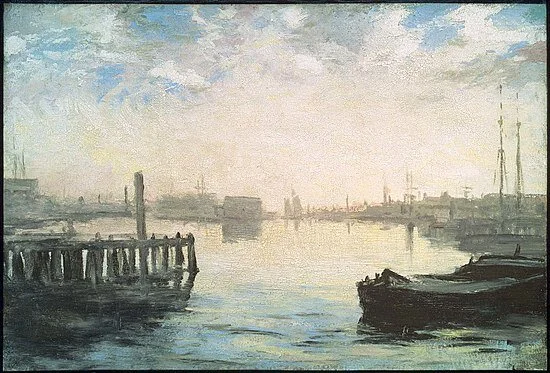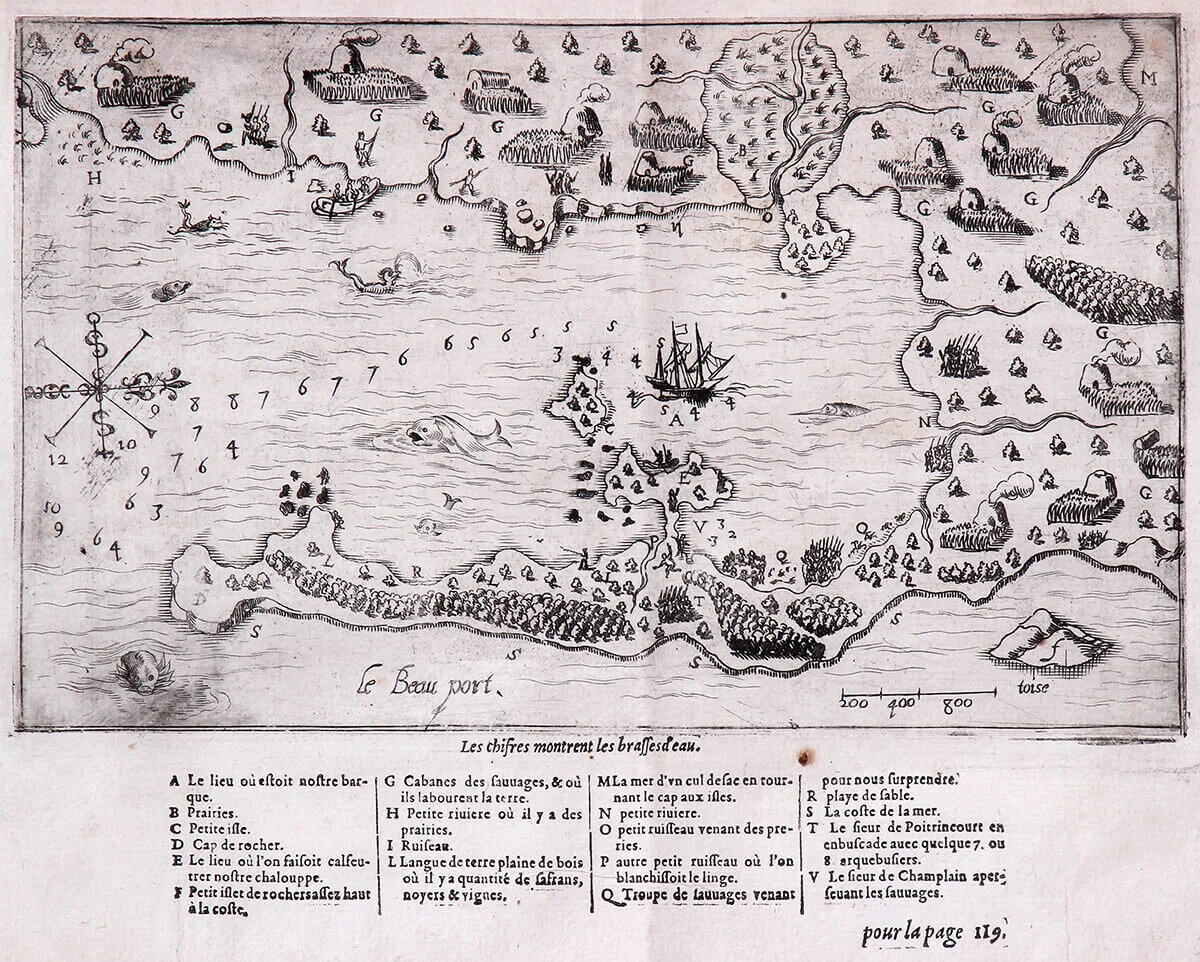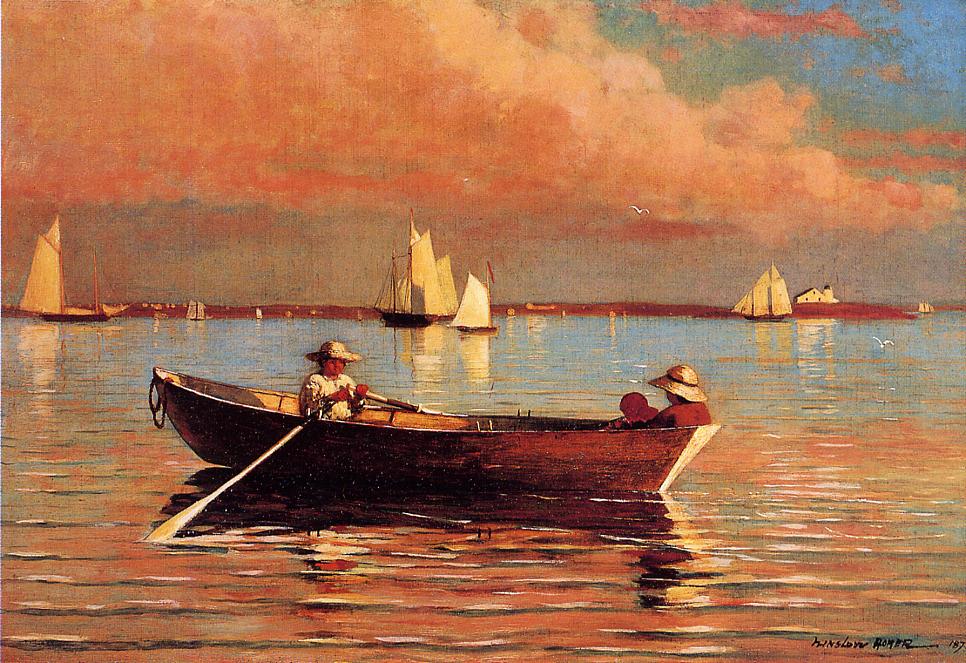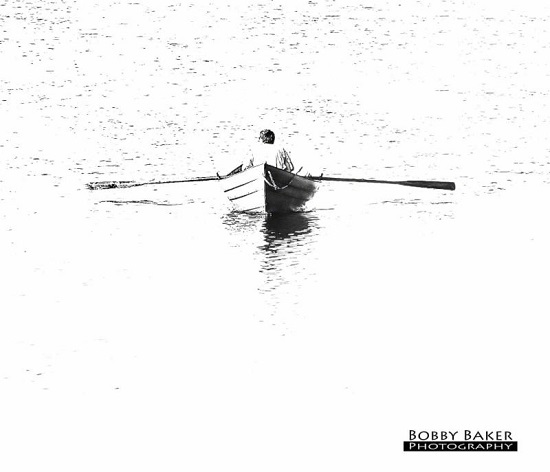
Love at the Cape Ann Museum
Above, Valentine shadow boxes from the archives of the Cape Ann Art Museum, Gloucester, Mass. Below, also at the museum, Sailors' Valentine, 1800-1840 (shell and glass on wood)
After a nuclear explosion
“Moonlight Scene” (oil on board), by Allan Freelon (1895-1960), at the Cape Ann Museum, Gloucester, Mass.
'The port is near'
Gloucester Harbor ca. 1877, by William Morris Hunt
It is time to be old,
To take in sail:—
The god of bounds,
Who sets to seas a shore,
Came to me in his fatal rounds,
And said: “No more!
No farther shoot
Thy broad ambitious branches, and thy root.
Fancy departs: no more invent;
Contract thy firmament
To compass of a tent.
There’s not enough for this and that,
Make thy option which of two;
Economize the failing river,
Not the less revere the Giver,
Leave the many and hold the few.
Timely wise accept the terms,
Soften the fall with wary foot;
A little while
Still plan and smile,
And,—fault of novel germs,—
Mature the unfallen fruit.
Curse, if thou wilt, thy sires,
Bad husbands of their fires,
Who, when they gave thee breath,
Failed to bequeath
The needful sinew stark as once,
The Baresark marrow to thy bones,
But left a legacy of ebbing veins,
Inconstant heat and nerveless reins,—
Amid the Muses, left thee deaf and dumb,
Amid the gladiators, halt and numb.”
As the bird trims her to the gale,
I trim myself to the storm of time,
I man the rudder, reef the sail,
Obey the voice at eve obeyed at prime:
“Lowly faithful, banish fear,
Right onward drive unharmed;
The port, well worth the cruise, is near,
And every wave is charmed.”
“Terminus,’’ by Ralph Waldo Emerson (1803-1882) the American essayist, lecturer, philosopher, and poet who led the New England-based transcendentalist movement of the mid-19th Century.
Have a seat, or maybe not
“Comfort Taken,’’ by Leslie Lyman, at Boston Sculptors Gallery, Jan. 27-Feb. 21. This was installed in the White-Ellery House, built 1710, in Gloucester
“Comfort Taken’’ presents the chair as a symbol of home and family—imperfect, used, repaired, held together with effort, work and continued perseverance.
White-Ellery House. It’s so old that its design looks late medieval English.
Kindly light
“Eastern Point Light, 1940s’’ (watercolor on paper), by Alfred Levitt (1894-2000) at the Cape Ann Museum, Gloucester, Mass.
Fresnel Lens for lighthouses originally designed by Augustine Jean Fresnel and displayed at the Cape Ann Museum.
Pre-turbine wind power
“Brig ‘Cadet’ in Gloucester Harbor,’’ late 1840s (oil on canvas), by Fitz Henry Lane (1804-1865), Cape Ann Museum, Gloucester. (Gift of Isabel Babson Lane).
Mellow day on Cape Ann
“Head of Goose Cove, Annisquam” (oil on canvas, circa 1910), by George L. Noyes (1864-1954), at the Cape Ann Museum, Gloucester.
Its attractions were clear
Map of Gloucester Harbor (“le beau port’) drawn as a result of an exploratory voyage along the New England coast led by Samuel de Champlain (ca. 1567-1635). This was originally printed in Paris in 1613. It’s now at the Cape Ann Museum, in Gloucester.
And October is apple month
“Still Life with Apples” (oil on canvas) by William Meyerowitz (1896-1981) at the Cape Ann Museum, Gloucester, Mass.
This from the museum:
"Who could know better than the people of Cape Ann how to cook fish?" That's how the 1958 Cape Ann Cook Book begins, and at the Cape Ann Museum, we couldn't agree more. In CAM Connects we take a look at not only the fish that made Gloucester famous, but the food that inspired artists and residents in our area to share their takes! We also tour an early 19th Century kitchen and delve into the history of Victorian trade cards and their relationship to food.’’
Getting to it in Gloucester
This painting, by Emile A. Gruppe (1896-1978), is owned by VNA Care and is now at the Cape Ann Museum, in Gloucester. It shows a young nurse standing at the top of the stairway that joins Friend and Main Streets in Gloucester.
Fresh visions in close quarters, too
“Owl's Head, Penobscot Bay, Maine,’’ by Fitz Henry Lane, (1804-65), at the Museum of Fine Arts, Boston.
Layla Bermeo is the MFA’s Kristin and Roger Servison Associate Curator of Paintings, Art of the Americas. She had this comment on the painting:
‘‘….My attention always lingers on the lone figure in the bottom left, standing with his back turned, holding a pole. Even with the sense of stillness that pervades the canvas, I feel a tension between his immobility and the movement of the ships, which seem to drift away from his gaze, shrinking in the background. This tension is echoed in Lane’s own biography, as he lived with a disability that limited his mobility but spent his career painting ships that traveled very far, very fast.
“As we try to reduce the spread of COVID-19 by restricting our movements, we can feel frozen, watching the rest of the world swirl around us, if not from a shore, then on a screen. But Lane’s work suggests that smaller environments—those we can encounter in a short car drive or neighborhood walk, or even within our own basements or closets—hold greater possibilities than we often notice.
“When scholars reference Lane’s disability, they usually mention what he could not do—he could not study in Europe like other American artists; he could not explore the wilderness like other landscape painters. But he could walk with crutches or a cane, and he did travel across the coasts of Maine and Massachusetts, bringing a fresh vision to the familiar ports of Gloucester, Salem, and Boston. If we stop thinking in terms of what we cannot do, like Lane may have done, how might we see our surroundings differently?”
"A father and son's journey in paint'
(left) Tom Nicholas, “Late Autumn, Rockport Harbor’’’ (oil on canvas, private collection), by Tom Nicholas); right, “Old Harbor, Gloucester’’ (oil on canvas; private collection), by T.M. Nicholas, in the show “Tom and T.M. Nicholas: A Father and Son’s Journey in Paint,’’ through April 12 at the Cape Ann Museum, Gloucester.
“Man at the Wheel,’’ Fisherman's Memorial Cenotaph, in Gloucester, a major fishing port for hundreds of years
Deadly work
Man at the Wheel, Fisherman's Memorial Cenotaph, in Gloucester.
“There are houses in Gloucester where groves have been worn into the floorboards by women pacing past an upstairs window, looking out to sea….If fishermen lived hard, it was no doubt because they died hard as well.’’
— Sebastian Junger, in The Perfect Storm (1997)
“Gloucester Harbor”” (circa 1877), by Richard Morris Hunt
'Come home to Gloucester town'
The “Dogtown’’ part of the Gloucester Moors, about 2008.
“Gloucester Harbor’ (1873) (oil on canvas), by Winslow Homer.
“Man at the Wheel,’’ Fisherman's Memorial Cenotaph, in Gloucester.
“A mile behind is Gloucester town
Where the fishing fleets put in,
A mile ahead the land dips down
And the woods and farms begin.
Here, where the moors stretch free
In the high blue afternoon,
Are the marching sun and talking sea,
And the racing winds that wheel and flee
On the flying heels of June.
Jill-o'er-the-ground is purple blue,
Blue is the quaker-maid,
The wild geranium holds its dew
Long in the boulder's shade.
Wax-red hangs the cup
From the huckleberry boughs,
In barberry bells the grey moths sup,
Or where the choke-cherry lifts high up
Sweet bowls for their carouse.
Over the shelf of the sandy cove
Beach-peas blossom late.
By copse and cliff the swallows rove
Each calling to his mate.
Seaward the sea-gulls go,
And the land-birds all are here;
That green-gold flash was a vireo,
And yonder flame where the marsh-flags grow
Was a scarlet tanager.
This earth is not the steadfast place
We landsmen build upon;
From deep to deep she varies pace,
And while she comes is gone.
Beneath my feet I feel
Her smooth bulk heave and dip;
With velvet plunge and soft upreel
She swings and steadies to her keel
Like a gallant, gallant ship.
These summer clouds she sets for sail,
The sun is her masthead light,
She tows the moon like a pinnace frail
Where her phosphor wake churns bright.
Now hid, now looming clear,
On the face of the dangerous blue
The star fleets tack and wheel and veer,
But on, but on does the old earth steer
As if her port she knew.
God, dear God! Does she know her port,
Though she goes so far about?
Or blind astray, does she make her sport
To brazen and chance it out?
I watched when her captains passed:
She were better captainless.
Men in the cabin, before the mast,
But some were reckless and some aghast,
And some sat gorged at mess.
By her battened hatch I leaned and caught
Sounds from the noisome hold,--
Cursing and sighing of souls distraught
And cries too sad to be told.
Then I strove to go down and see;
But they said, "Thou art not of us!"
I turned to those on the deck with me
And cried, "Give help!" But they said, "Let be:
Our ship sails faster thus."
Jill-o'er-the-ground is purple blue,
Blue is the quaker-maid,
The alder-clump where the brook comes through
Breeds cresses in its shade.
To be out of the moiling street
With its swelter and its sin!
Who has given to me this sweet,
And given my brother dust to eat?
And when will his wage come in?
Scattering wide or blown in ranks,
Yellow and white and brown,
Boats and boats from the fishing banks
Come home to Gloucester town.
There is cash to purse and spend,
There are wives to be embraced,
Hearts to borrow and hearts to lend,
And hearts to take and keep to the end,--
O little sails, make haste!
But thou, vast outbound ship of souls,
What harbor town for thee?
What shapes, when thy arriving tolls,
Shall crowd the banks to see?
Shall all the happy shipmates then
Stand singing brotherly?
Or shall a haggard ruthless few
Warp her over and bring her to,
While the many broken souls of men
Fester down in the slaver's pen,
And nothing to say or do?’’
— “Gloucester Moors,’’ by William Vaughn Moody (1869-1910)
'Thousand shifting nuances'
View of Gloucester Harbor, circa 1915.
"Not infrequently this almost landlocked bowl of the heavenliest light you ever experienced, in its thousand shifting nuances from day to night and night to day, scowl to smile, season to season, has been compared to the Bay of Naples alone. And many the traveler has rounded the world, only to return, gaze about him, breathe a deep sigh, and announce as if he had the tablets in hand at last that there was nowhere, anywhere, for that interplay of land and sea and sky and inhabitants to surpass the old, old fishing port of Gloucester, on the North Shore of Massachusetts Bay.''
-- From The North Shore, by Joseph E. Garland
Gloucester urged to promote underused fish to boost its economy
From ecoRI news
GLOUCESTER, Mass.
Environmental Protection Agency regional administrator Curt Spalding visited the city June 15 to applaud the commencement of a workshop to help the North Shore community promote the use of underused fish species as a way to support the local economy, address food insecurity and help revitalize downtown.
The workshop is being conducted as part of the White House Rural Council’s effort to promote “Local Foods, Local Places” — a federal initiative that helps communities increase economic opportunities for local food producers and related businesses and improves access to healthy local food.
Gloucester is one of 27 communities in 22 states that has been selected to participate in the program, and is the only New England municipality selected. More than 300 applicants were received.
“By working together to bring healthy local food to market, we can ensure we are making the right decisions for our environment, for public health and for our economy,” Spalding said.
The workshop started with a public meeting at the Gloucester House Restaurant on June 15, and continued June 16 with a planning session at City Hall. Gloucester will next receive a “Next Steps” report that describes options for actions the city and its partners can take to support a healthier and stronger Gloucester through local food and community planning strategies.
Quilting up a storm in Gloucester
From an exhibition of quilts by members of the Rose Baker Senior Center in Gloucester, Mass., at the Cape Ann Museum there.
Above, left to right: "Portuguese Hill." Quilt, mixed media. Linen backing made possible through grants from the Massachusetts Cultural Council. Gift of the Art Program at Gloucester's Rose Baker Senior Center, 2015. [Acc. #2015.033.09]; "West Gloucester." Quilt, mixed media. Linen backing made possible through grants from the Massachusetts Cultural Council. Gift of the Art Program at Gloucester's Rose Baker Senior Center, 2015. [Acc. #2015.033.08]; "Magnolia." Quilt, mixed media. Linen backing made possible through grants from the Massachusetts Cultural Council. Gift of the Art Program at Gloucester's Rose Baker Senior Center, 2015. [Acc. #2015.033.03]
Outside in
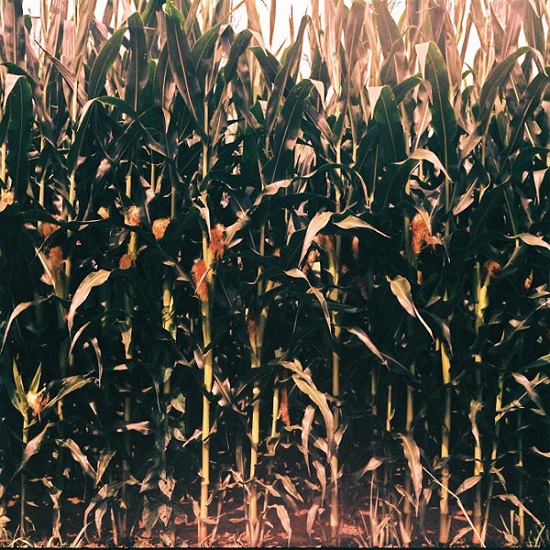 From the show "Bringing the Outside In,'' by JULY WHITE and KYLE NILAN, at the White-Ellery House, in Gloucester, Mass., July 5, from 11 a.m. to 3 p.m. Through a collection of audio and visual art, White and Nilan investigate “the outside” and their relationship to it as visitors, inhabitants and collectors.
From the show "Bringing the Outside In,'' by JULY WHITE and KYLE NILAN, at the White-Ellery House, in Gloucester, Mass., July 5, from 11 a.m. to 3 p.m. Through a collection of audio and visual art, White and Nilan investigate “the outside” and their relationship to it as visitors, inhabitants and collectors.



